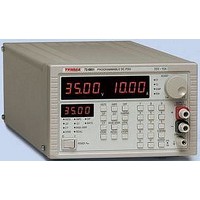72-6851 TENMA, 72-6851 Datasheet - Page 12

72-6851
Manufacturer Part Number
72-6851
Description
POWER SUPPLY, BENCH, 35V
Manufacturer
TENMA
Datasheet
1.72-6851.pdf
(33 pages)
Specifications of 72-6851
Power Supply Output Type
Variable
No. Of Outputs
1
Output Voltage
35V
Output Current
10A
Load Regulation
0.01%
Length
350.52mm
Width
210.82mm
Height
132.08mm
Output Type
Variable
Calibrated
No
Rohs Compliant
NA
Lead Free Status / RoHS Status
na
Tenma 72-6851 & 72-6853 Instruction manual
Interface Selection
Address and Baud Rate Selection
Remote/Local Operation
The instrument can be remotely controlled via its RS232 or GPIB interfaces. When using RS232
it can either be the only instrument connected to the controller or it can be part of an Addressable
RS232 Chain (ARC) which permits up to 32 instruments to be addressed from one RS232 port.
Some of the following sections are general and apply to all 3 modes (single instrument RS232,
ARC and GPIB); others are clearly only relevant to a particular interface or mode. It is only
necessary to read the general sections plus those specific to the intended remote control mode.
Remote command format and the remote commands themselves are detailed in the Remote
Commands chapter.
All power supplies in the range are fitted with both an ARC (Addressable RS232 Chain) interface
and a GPIB interface. Before an interface can be used it must be selected and assigned an
address and/or baud rate. To select an interface press the I/F key. The status display will show
either
interface may be changed by pressing the
display press the CONFIRM key to make it active. Pressing the ESCAPE key will exit without
making any changes.
For successful operation, each instrument connected to the GPIB or Addressable RS232 Chain
(ARC) must be assigned a unique address and, in the case of addressable RS232, all must be
set to the same baud rate.
Pressing the BAUD/ADDR key will alternately show baud rate or address if RS232 is selected or
address only if GPIB is selected; the BAUD/ADDR LED will also be on.
To select baud rate the
required value is displayed press the CONFIRM key to make it active. Pressing the ESCAPE key
will exit without making any changes. Selectable baud rates are 300, 600, 1200, 2400, 4800 and
9600.
To select address enter the required number from the numeric key pad. When the required value
is displayed press the CONFIRM key to make it active. Pressing the ESCAPE key will exit without
making any changes. The range of addresses accepted is 0 to 30.
A change of address will become active immediately it is entered from the keyboard and the
device will no longer respond to the previous address.
All device operations are performed through a single primary address, no secondary addressing
is used; the default address is 11. When the address is changed the new setting is stored in non-
volatile ram, and will remain unchanged even while power is off.
The address setting is ignored in single instrument RS232 operation.
At power-on the instrument will be in the local state with the REMOTE LED off. In this state all
keyboard operations are possible. When the instrument is addressed (to talk or listen) the remote
state will be entered and the REMOTE LED will be turned on. In this state the keyboard is locked
out and remote commands only will be processed. The instrument may be returned to the local
state by pressing the LOCAL key; however, the effect of this action will remain only until the
instrument is addressed again or receives another character from the interface, when the remote
state will once again be entered. The Controller may disable the LOCAL key under GPIB control
by sending a Local Lock Out command; the instrument keyboard will then remain inoperative until
the Controller sends a Go To Local command or sets the REN interface line false.
“232” if RS232 is currently selected or “488” if GPIB is selected. The selected
and
keys are used to cycle through all available values. When the
www.tenma.com
or
keys. Once the required interface is in the
Remote Operation
11



















